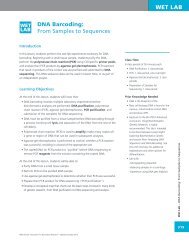LESSON 4 Using Bioinformatics to Analyze Protein Sequences
LESSON 4 Using Bioinformatics to Analyze Protein Sequences
LESSON 4 Using Bioinformatics to Analyze Protein Sequences
You also want an ePaper? Increase the reach of your titles
YUMPU automatically turns print PDFs into web optimized ePapers that Google loves.
<strong>LESSON</strong> 442. Explain that genetic researchers use the <strong>to</strong>ols of bioinformatics <strong>to</strong> help themanalyze DNA sequences and determine which potential protein sequenceis the correct one for their analysis. In particular, a popular <strong>to</strong>ol used byresearchers is called ORF Finder—Open Reading Frame Finder—and is availablethrough the NCBI.43. Ask students <strong>to</strong> pull out Student Handout—<strong>Using</strong> <strong>Bioinformatics</strong> <strong>to</strong> StudyEvolutionary Relationships from Lesson Three because they will refer <strong>to</strong> theiranswers on this handout during the next exercise.44. Pass out Student Handout—<strong>Using</strong> <strong>Bioinformatics</strong> Tools <strong>to</strong> <strong>Analyze</strong> <strong>Protein</strong><strong>Sequences</strong> Instructions and Student Handout—<strong>Using</strong> <strong>Bioinformatics</strong> Tools <strong>to</strong><strong>Analyze</strong> <strong>Protein</strong> <strong>Sequences</strong> Worksheet and ask the students <strong>to</strong> work throughthe handout at the computer either individually, in pairs, or in groups of up <strong>to</strong>four students each.PART III: Putting it All Together45. After students have completed their handout and worked with theircollabora<strong>to</strong>rs (group members) <strong>to</strong> answer the questions, ask students <strong>to</strong> workwithin their groups <strong>to</strong> prepare a short summary of what they have learned.This could be a short written summary prepared in class or assigned ashomework. Alternatively, student representatives from each group could sharethe following information orally with the class. Some questions <strong>to</strong> ask include:• How many reading frames did their sequences have that were longer than100 amino acids?Answers will vary, but usually 2-5 frames will contain proteins this long.• Were students surprised <strong>to</strong> see how many potential reading frames ORFFinder found in their sequences?Students may be surprised <strong>to</strong> see that more than one frame contained suchlong protein sequences.• Do students predict conservative or non-conservative amino acid changeswill have a larger impact on protein function?ClosureUsually non-conservative changes have a more detrimental effect onprotein function.46. Summarize <strong>to</strong>day’s lesson:• Students have learned how <strong>to</strong> translate DNA sequences in<strong>to</strong> protein usingcodon tables and using the bioinformatics <strong>to</strong>ol ORF Finder.• In addition, they have learned that they can perform multiple sequencealignments with DNA or protein sequences. Whether scientists use DNAor protein sequences for the alignment often depends on the researchquestion and hypothesis of the genetic researcher.• DNA sequences are easy <strong>to</strong> obtain and analyze without knowing anythingabout the protein the DNA may encode, and DNA is the material of[Note: Because of the redundancy ofthe genetic code, in which multiplecodons may encode the same aminoacid, the DNA and correspondingprotein sequence may appear <strong>to</strong> vary atdifferent rates.]Lesson 4 – <strong>Using</strong> <strong>Bioinformatics</strong> <strong>to</strong> <strong>Analyze</strong> <strong>Protein</strong> <strong>Sequences</strong>135©Northwest Association for Biomedical Research—Updated Oc<strong>to</strong>ber 2012
















